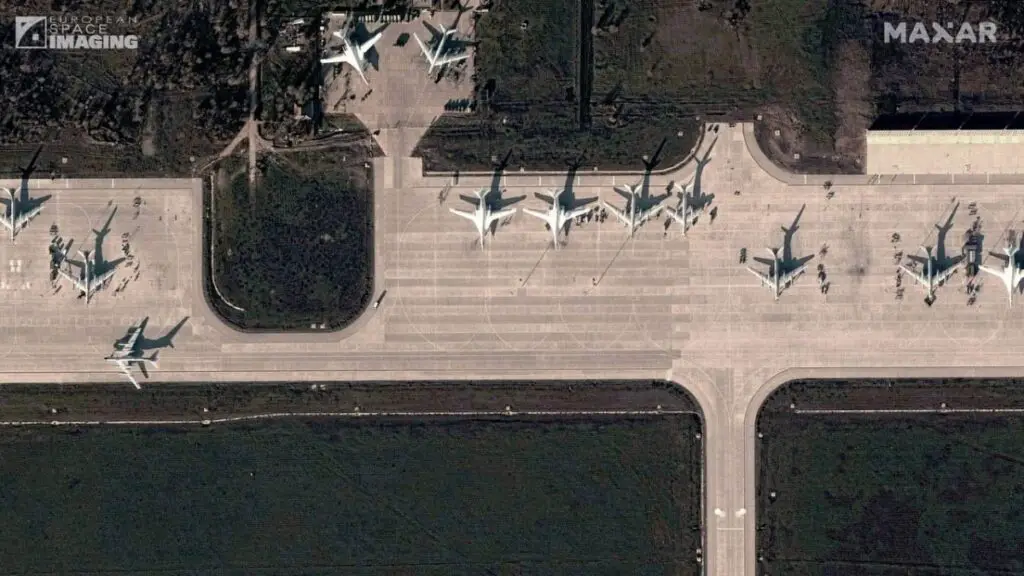On the morning of December 5, extraordinary events took place at two Russian air bases at once. An explosion happened at the Russian Dyagilevo military airfield of Ryazan, southeast of Moscow, leaving at least three people dead. A second explosion occurred at the airport near Saratov named Engels-2.
The 121st Guards Sevastopol and 184th Heavy Bomber Aviation Regiments, equipped with Tu-160 and Tu-95MS strategic bombers, are deployed to the Engels air base. Each air regiment was a component of the 22nd Guards Heavy Bomber Aviation Donbas Red Banner Division. The sole location where Tu-160 strategic bombers are stationed is the Engels air base.
At the same time, Dyagilevo is intended for Tu-95MS training and serves as a logistical hub for Russian transport aircraft. According to the Russian Federation’s Ministry of Defense, the Dyagilevo air base is located in the western suburbs of Ryazan, and the 360th Aircraft Repair Plant is adjacent to the air base. The air base hosts Il-76 tanker aircraft, and the 43rd Center for combat usage and retraining of flying personnel (long-range aviation personnel) operates.
There are two versions of the cause of attacks. The telegram channels have reported drone attacks, but the official Russian sources have blamed it on a fuel tank explosion in Dyagilevo. Russia has not commented on the Engels attack.
The news that an explosion happened at the Engels strategic aviation facility early on December 5 was reported by the Rybar military channel, along with surveillance camera footage. According to unsubstantiated reports, two Tu-95 missile carriers were damaged, and an attack by a Ukrainian drone cannot be ruled out.
The attack’s political impact cannot be overstated. Engels is the primary base for Russia’s strategic aircraft, a component of the country’s nuclear “triad.” It is from there that planes launch missile attacks on Ukraine. The front line is around 700 kilometres away. At the same time, 500 kilometres separate Dyagilevo, where Tu-22M3s are based for training purposes.
Maxar Satellites detect huge bomber activities at Engels
On December 1, Western newsmakers discovered many Tu-160 and Tu-95MS strategic bombers at the Engels air base. This was first reported by the German edition of Der Spiegel, citing satellite images from Maxar Technologies and Planet Labs on November 28.
Based on the satellite image of the Russian military airbase Engels, at least nine Tu-160 strategic supersonic bombers and at least nineteen Tu-95 strategic bomber-missile carriers were positioned on its grounds, representing about one-third of Russia’s strategic aviation forces. The An-124 military transport aircraft was also captured on camera. The presence of boxes, tankers, and aircraft maintenance suggests that the military facility is extremely active.
The site’s authors questioned the true motives for deploying “such a big number of strategic aircraft” at the air base, which, according to some accounts, can be used to attack the Armed Forces of Ukraine in Ukraine.

In addition, on the airfield near the planes, there are tankers, and you can see numerous large boxes of ammunition, vehicles and repair materials.
“Activity at the base is extremely high… There are many large cargo planes parked on the runway, indicating a recent large shipment of possibly cruise missiles to the base,” military analyst Arda Mevlutoglu said in a commentary to the publication.
Rochan Consulting military expert Konrad Muzyka also believes that the Russian base is on high alert. “There are many movements on the ground. Aircraft are being serviced and apparently being prepared for new operations. You can also see tractors that are used to transport Kh-55 or Kh-101 cruise missiles,” he said.
However, the Ukrainian Main Intelligence Directorate said they were aware of the presence of strategic bombers at Engels but denied that they were there to mount attacks on Ukraine. The Directorate said that the Tu-95s were recently moved from Dyagilevo to Engels.
The Ukrainian administration had asked the civilians not to live in fear of imminent bombing but to rely on the warning systems of the administration.
Ukraine’s 1000 km attack drone
Although the Ukrainian government has not yet issued an official statement regarding the drone strike on the Engels airbase, the country is suspected of carrying out the attack.
Ukraine does not possess long-range drones capable of attacking the Engels airbase, but it is testing a drone that can fly 1,000 kilometres and carry 75 kg of explosives.
On December 4, “Ukroboronprom” said it was entering the last phase of testing a Ukrainian assault drone.
Natalya Sad, the press secretary of Ukroboronprom, said that the stage of testing under the influence of electronic warfare was being conducted per the directives of the Chief of the Ukrainian Armed Forces General Staff.
“After we successfully test the drone under the influence of electronic warfare, we hope that we will be able to see it in We promised before the end of this year – we are trying to keep our promises,” she said.
